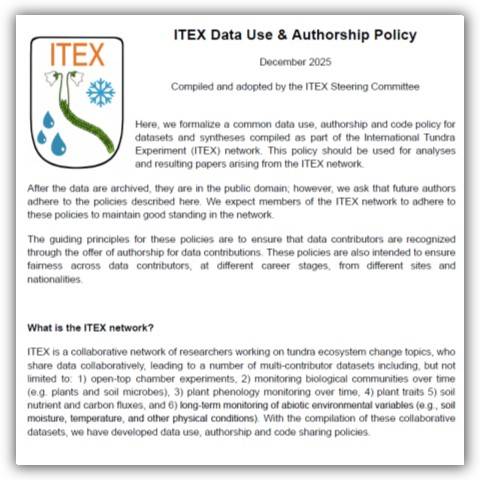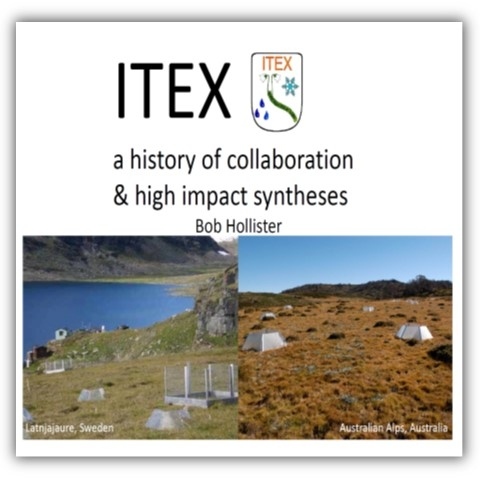Synthesis & Data
The power of the ITEX network is the ability to do quantitative synthesis of pooled data collected across the tundra biome. These syntheses are possible because of a shared set of protocols described in the ITEX Manual and have resulted in hundreds of publications. The synthesis activities are the lifeblood that sustains the ITEX network. The results of these syntheses are generally of great interest to a wide array of researchers and policy makers. The continued presence of researchers at the ITEX sites also servers as a platform to access soil or plant tissue samples from across the tundra biome.
Using ITEX datasets
The ITEX network has agreed to make all data publically available as part of the agreed upon data sharing policy. However, we ask that users of the data strongly consider offering authorship to all data contributors. High profile publications are the best way to assure that these sites are maintained and that future data sets will be available. Including data contributors as authors also assures that the data are used properly and that the conclusions drawn from the analysis are valid and meaningful.
Plant composition data (both ITEX OTC plots and sites with only long-term monitoring) Anne Bjorkman
Plant phenology data Isla Myers-Smith
Ecosystem carbon flux data Mats Björkman
Please contact the person listed above for access to the most up to date database and to add data (either new years or new sites).
The ITEX data use policy is described here.
Add comments here:
ITEX Data Use & Authorship Policy - Google Docs
Links to Archived ITEX Datasets and Code
- Phenology database publicly available at the Polar data catalogue, the data paper is Prevéy et al. 2022 Arctic Science
- data from the Elmendorf et al 2012 syntheses (Nature Climate Change & Ecology Letters) are in the polar data catalog
- list of data papers, links to datasets in repositories (work in progress), here https://github.com/ITEX-sites/ITEX
- Contributor to Tundra Trait Team the data paper is Bjorkman et al. 2018 Global Ecology and Biogeography
- Contributor to TRY Plant Trait Database
- Contributor to Team Shrub
- Contributor to BioTime the data paper is BioTIME 2.0: Expanding and improving a database of biodiversity time series
- Contributor to Arctic Vegetation Archive a data paper is Walker et al. 2016 Phytocoenologia
[1763476232].jpg)
ITEX slack
Join the ITEX slack group to discuss ask questions and share code for analysis commonly done on by members of the ITEX community.
View a brief Github and Slack tutorial: https://drive.google.com/file/d/1NZHceLRWBmc3j10qlzRB2u8UBXNmjDZO/view?usp=drive_link
Ongoing and planned synthesis activities using the ITEX network or ITEX data sets are:
The network is eager to expand synthesis efforts. Talk to a member of the steering committee or chair about leading a new synthesis activity.
Cryptogams & microclimate (Mariana García Criado) email
Soil organic matter in Pan-Arctic Tundra soil (You Jin Kim) email
Linking root traits with above ground phenology (Elise Gallois)
Mycorrhiza (Kevin Van Sundert)
Arctic vascular plant functional diversity (Joseph Everest)
Fungal mycelia collection (Cole Brachmann) email of fungal mycelia collection explanation
Arctic vascular plant phylogenetic diversity (Ruud Scharn)
Coexistence theory (Yanhao Feng)
Birch leaf samples (Jolanta Rieksta) email
Seed collection (Sergey Rosbakh & Jeronimo Vázquez-Ramírez) email update on regenerative traits
Oxyria collection (Anne Bjorkman) email & protocol
NDVI of plots (Jeremy May) email of NDVI collection and synthesis
Cassiope collection (Elise Gallois) email of Cassiope collection explanation
Dryas (formerly Draba) genetics UBC (Emily Grishaber) email (Cassandra Elphinstone) email of Dryas genetics explanation MS word description of Dryas genetics
Species Pool (Christian Rixen & Anne Bjorkman & Gergana N. Daskalova & Signe Normand & Jeremy Borderieux) Link to protocol: https://osf.io/agdfq/
Plant Community Synthesis (Robert Björk & Ruud Scharn)
Tundra Trait Team website (Anne Bjorkman)
Herbivore Activity website (Isabel Barrio)
Eriophorum vaginatum material (Ned Fetcher)
Common Garden (Anne Bjorkman)
sTundra hosted by iDiv (Isla Myers-Smith, Anne Bjorkman, & Sarah Elmendorf)
You can add updates here:
https://docs.google.com/document/d/1oHvam_eFOlI0-2Qs10ZXkJ-u1HDfQpAZxsjuu8ykHwY/edit?usp=sharing
ITEX's Collaborative Efforts (History)
Collaborative efforts either led by ITEX members or consisting of several ITEX members.
2025
- García Criado et al. 2025. Plant diversity dynamics over space and time in a warming Arctic. Nature 642:653–661. 10.1038/s41586-025-08946-8.
- García Criado et al. 2025. Borealisation of plant communities in the Arctic is driven by boreal‐tundra species. Ecology Letters 28:e70209. 10.1111/ele.70209.
- Gallois et al. 2025. Tundra vegetation community type, not microclimate, controls asynchrony of above‐ and below‐ground phenology. Global Change Biology 31:e70153. 10.1111/gcb.70153.
- Schwieger et al. 2025. Environmental conditions modulate warming effects on plant litter decomposition globally. Ecology Letters 28:e70026. 10.1111/ele.70026.
- Lu et al. 2025. Diminishing warming effects on plant phenology over time. New Phytologist 245:523–533. 10.1111/nph.20019.
2024
-
Maes et al. 2024. Environmental drivers of increased ecosystem respiration in a warming tundra. Nature 629:105–113. 10.1038/s41586-024-07274-7.
-
Elphinstone et al. 2024. Multiple Pleistocene refugia for Arctic Bell‐Heather revealed with genomic analyses of modern and historic plants. Journal of Biogeography 51:1958–1973. 10.1111/jbi.14961.
2023
- García Criado et al. 2023. Plant traits poorly predict winner and loser shrub species in a warming tundra biome. Nature Communications 14:3837. 10.1038/s41467-023-39573-4.
- Hollister et al. 2023. A review of open top chamber (OTC) performance across the ITEX Network. Arctic Science 9:331–344. 10.1139/as-2022-0030.
2022
- Henry et al. 2022. The International Tundra Experiment (ITEX): 30 years of research on tundra ecosystems. Arctic Science 8:550–571. 10.1139/as-2022-0041.
- Rixen et al. 2022. Winters are changing: Snow effects on Arctic and alpine tundra ecosystems. Arctic Science 8:572–608. 10.1139/as-2020-0058.
- Lett et al. 2022. Can bryophyte groups increase functional resolution in tundra ecosystems? Arctic Science 8:609–637. 10.1139/as-2020-0057.
- Jeanbille et al. 2022. Site-specific responses of fungal and bacterial abundances to experimental warming in litter and soil across Arctic and alpine tundra. Arctic Science 8:992–1005. 10.1139/as-2020-0053.
- Prevéy et al. 2022. The tundra phenology database: More than two decades of tundra phenology responses to climate change. Arctic Science 8:1026–1039. 10.1139/as-2020-0041.
- [Special issue: Arctic Science]
2021
- Collins et al. 2021. Experimental warming differentially affects vegetative and reproductive phenology of tundra plants. Nature Communications 12:3442. 10.1038/s41467-021-23841-2.
2020
- Myers-Smith et al. 2020. Complexity revealed in the greening of the Arctic. Nature Climate Change 10:106–117. 10.1038/s41558-019-0688-1.
- Thomas et al. 2020. Global plant trait relationships extend to the climatic extremes of the tundra biome. Nature Communications 11:1351. 10.1038/s41467-020-15014-4.
2019
- Prevéy et al. 2019. Warming shortens flowering seasons of tundra plant communities. Nature Ecology & Evolution 3:45–52. 10.1038/s41559-018-0745-6.
- Thomas et al. 2019. Traditional plant functional groups explain variation in economic but not size‐related traits across the tundra biome. Global Ecology and Biogeography 28:78–95. 10.1111/geb.12783.
- Assmann et al. 2019. Local snow melt and temperature—but not regional sea ice—explain variation in spring phenology in coastal Arctic tundra. Global Change Biology 25:2258–2274. 10.1111/gcb.14639.
2018
- Bjorkman et al. 2018. Plant functional trait change across a warming tundra biome. Nature 562:57–62. 10.1038/s41586-018-0563-7.
- Bjorkman et al. 2018. Tundra Trait Team: A database of plant traits spanning the tundra biome. Global Ecology and Biogeography 27:1402–1411. 10.1111/geb.12821.
2017
- Prevéy et al. 2017. Greater temperature sensitivity of plant phenology at colder sites: Implications for convergence across northern latitudes. Global Change Biology 23:2660–2671. 10.1111/gcb.13619.
2015
- Elmendorf et al. 2015. Experiment, monitoring, and gradient methods used to infer climate change effects on plant communities yield consistent patterns. Proceedings of the National Academy of Sciences 112:448–452. 10.1073/pnas.1410088112.
2013
- Oberbauer et al. 2013. Phenological response of tundra plants to background climate variation tested using the International Tundra Experiment. Philosophical Transactions of the Royal Society B: Biological Sciences 368:20120481. 10.1098/rstb.2012.0481.
- Bokhorst et al. 2013. Variable temperature effects of Open Top Chambers at polar and alpine sites explained by irradiance and snow depth. Global Change Biology 19:64–74. 10.1111/gcb.12028.
2012
- Elmendorf et al. 2012. Global assessment of experimental climate warming on tundra vegetation: Heterogeneity over space and time. Ecology Letters 15:164–175. 10.1111/j.1461-0248.2011.01716.x.
- Elmendorf et al. 2012. Plot-scale evidence of tundra vegetation change and links to recent summer warming. Nature Climate Change 2:453–457. 10.1038/nclimate1465.
2007
- Oberbauer et al. 2007. Tundra CO2 fluxes in response to experimental warming across latitudinal and moisture gradients. Ecological Monographs 77:221–238. 10.1890/06-0649.
2006
- Walker et al. 2006. Plant community responses to experimental warming across the tundra biome. Proceedings of the National Academy of Sciences of the United States of America 103:1342–1346. 10.1073pnas.0503198103.
2005
1999
- Arft et al. 1999. Responses of tundra plants to experimental warming: Meta-analysis of the international tundra experiment. Ecological Monographs 69:491–511. 10.1890/0012-9615(1999)069[0491:ROTPTE]2.0.CO;2.
1997
- Henry and Molau. 1997. Tundra plants and climate change: The International Tundra Experiment (ITEX). Global Change Biology 3:1–9. 10.1111/j.1365-2486.1997.gcb132.x.
- Marion et al. 1997. Open-top designs for manipulating field temperature in high-latitude ecosystems. Global Change Biology 3:20–32. 10.1111/j.1365-2486.1997.gcb136.x.
- [Special Issue: Global Change Biology]


[1713039142].jpg)
